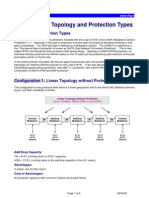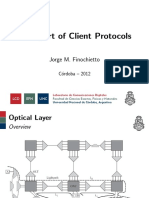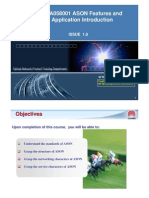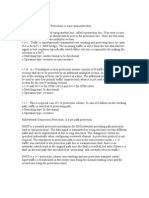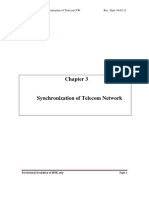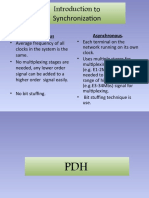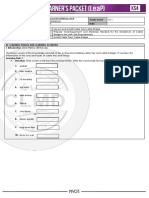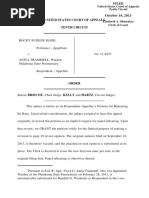SDH Overhead and Pointer
SDH Overhead and Pointer
Uploaded by
Mahmoud TahaCopyright:
Available Formats
SDH Overhead and Pointer
SDH Overhead and Pointer
Uploaded by
Mahmoud TahaOriginal Description:
Original Title
Copyright
Available Formats
Share this document
Did you find this document useful?
Is this content inappropriate?
Copyright:
Available Formats
SDH Overhead and Pointer
SDH Overhead and Pointer
Uploaded by
Mahmoud TahaCopyright:
Available Formats
Curriculum SS 0501 Issue 2.
SDH Principle
Section 3 Overhead and Pointer
Objectives:
To master implementation of section layer monitoring ---- functions of section overhead bytes. To master implementation of path layer monitoring ---- functions of path overhead bytes. To master which overhead bytes implement basic alarm and performance monitoring. To understand the operation mechanism for the pointer ---- AU-PTR and TU-PTR. To build the concepts of layered SDH monitoring.
3.1 Overhead
As mentioned before, the functions of overhead are to implement layered monitoring management for SDH signals. The monitoring is classified into section layer monitoring and path layer monitoring. The section layer monitoring is further classified into regenerator section layer monitoring and multiplex section layer monitoring while the path layer monitoring is further classified into higher order path layer and lower order path layer. Thus the layered monitoring for STM-N is implemented. For example, in a 2.5G system, the regenerator section overhead monitors the overall STM-16 signal while the multiplex section overhead further monitors each of the 16 STM-1. Furthermore, the higher order path overhead monitors the VC4 of each STM-1 and the lower order path overhead can monitor each of the 63 VC12 in the VC4. Hence the multistage monitoring functions from 2.5Gb/s to 2Mb/s are implemented. Then, how are these monitoring functions implemented? They are implemented via different overhead bytes.
3.1.1 Section Overhead
The section overhead of the STM-N frame is located in rows 1-9 of columns 1-9N with the frame structure. Notes: with the exception of row 4. We are to describe the function of each section overhead byte with the example of an STM-1 signal. For an 1
Curriculum SS 0501 Issue 2.0
SDH Principle
STM-1 signal, the SOH is located at rows 1-3 of columns 1-9 ---- RSOH and rows 5-9 of columns 1-9 ---- MSOH within its frame, as illustrated in Figure 3-1.
9 bytes A1 A1 A1 A2 A2 A2 J0 * * F1 B1 E1 D1 D2 D3
Administrative Unit Pointer(s)
RSOH
9 rows B2 B2 B2 K1
D4 D7
D10
K2 D6 D9
D12
D5 D8
D11
MSOH
S1
M1 E2
Media dependent bytes (temporary usage) Bytes reserved for use domestic * Unscrambled bytes All unmarked bytes are reserved for future international standardization
Figure 3-1 The diagram of section overhead bytes within the STM-N frame
Figure 3-1 illustrates the location of regenerator section overhead and multiplex section overhead within the STM-1 frame. What is the difference between them? Their difference is in the monitoring scope, i.e. the RSOH is corresponding to a large scope ---- STM-N while the MSOH is corresponding to a smaller scope ---STM-1 within the large scope.
Framing bytes A1 and A2
Like a pointer, the function of the frame bytes is alignment. As we know that SDH can add/drop lower-rate tributary signals from higher-rate signals. Why? Because the receiver can align the location of the lower-rate signals within the high-rate signal via the pointers ---- AU-PTR and TU-PTR. The first step of this procedure is to properly extract each STM-N frame from the received signal stream at the receiver, i.e. to align the start location of each STM-N frame, then to align the location of the corresponding lower-rate signals within each frame. This procedure is similar to locating a person in a long queue, you must first align the specific square, then align the person via the row and column within the square he belongs to. The function of the bytes A1 and A2 is to align the square. So the receiver can align and extract the STM-N frame from the information stream via these two bytes and further align a specific lower-rate signal within the frame via the pointers.
Curriculum SS 0501 Issue 2.0
SDH Principle
How does the receiver align the frames via the A1 and A2 bytes? The A1 and A2 have fixed value, i.e. fixed bit patterns: A1: 11110110 (f6H) and A2: 00101000(28H). The receiver monitors each byte in the stream. After detecting 3N successive f6H bytes followed by 3N 26H bytes (there are three A1 and three A2 bytes within an STM-1 frame), the receiver determines that an STM-N frame starts to be received. By aligning the start of each STM-N frame, the receiver can identify different STM-N frames and disassemble them. In the case of N=1, the frames identified are STM-1 frames. If the receiver doesn't receive A1 and A2 bytes within five or more successive frames (625us), i.e. it can't identify the start of five successive frames (identify different frames), it will enter out-of-frame status and generate out-of-frame alarm ---- OOF. If the OOF keeps for 3ms, the receiver will enter loss-of-frame status ---the equipment will generate loss-of-frame alarm ---- LOF. Meanwhile, an AIS signal will be sent downward and the entire services will be interrupted. Under LOF status, if the receiver stays in normal frame alignment status again for successive 1ms or more, the equipment will restore the normal status.
Technical details:
STM-N signals shall be scrambled before being transmitted via the line so that the receiver can extract timing signals from the line. But the A1 and A2 framing bytes shall not be scrambled for the receiver to properly align them. To take both requirements into consideration, the STM-N signals don't scramble the bytes in the first row (1 row9N columns, including A1 and A2 bytes ) of the section overhead but transmit them transparently while the other bytes within the STM-N frame are scrambled before transmitting via the line. Thus it is convenient to extract the timing from the STM-N signals and disassemble the STM-N signals at the receiver.
Regenerator Section Trace byte: J0
This byte is used to repeatedly transmit a Section Access Point Identifier so that a section receiver can verify its continued connection to the intended transmitter. Within the domain of a single operator, this byte may use any character. But at the boundaries between the networks of different operators, the format of J0 byte shall be the same (i.e. matched) between the receiver and transmitter of the equipment. Via J0 byte the operator can detect and solve faults early and shorten the network restoration time. Another usage of the J0 byte is that J0 byte in each STM-N frame is defined as an STM identifier C1 and used to indicate the location of each STM-1 within the STMN ---- indicating which STM-1 within the STM-N this STM-1 is (the value of interleave depth coordinate) and which column this C1 byte is located within the
Curriculum SS 0501 Issue 2.0
SDH Principle
STM-1 frame (the value of the multi-column). It may be used to assist the A1 and A2 bytes in frame alignment.
Data Communication Channel (DCC) byte: D1-D12
One of the features of SDH is its highly automatic OAM function which can conduct commands issue and performance auto poll to the networks element via network management terminals. SDH has some functions which are not possessed by PDH systems, such as real-time service allocation, alarm fault location and on-line performance testing. Where are these OAM data arranged to transmit? The data used for OAM functions, such as sent commands and checked alarm performance data, are transmitted via D1-D12 bytes within the STM-N frame, i.e. the related data for OAM functions are arranged in the locations of the D1-D12 bytes and transmitted by the STM-N signals via the SDH network. Thus the D1-D12 bytes provide a common data communication channel accessible to all SDH network elements. As the physical layer of the embedded control channel (ECC), the D1-D12 bytes transmit operation, administration and maintenance (OAM) information among the network elements and form a transmission channel of the SDH management network (SMN). D1, D2 and D3 are regenerator section DCC bytes (DCCR) with a rate of 364kb/s 192kb/s and are used to transmit OAM information among regenerator section terminals. D4-D12 are multiplex section DCC bytes (DCCM) with a sum rate of 964kb/s=576kb/s and are used to transmit OAM information among multiplex section terminals. The DCC has a total rate of 768kb/s which provides a powerful communication base for SDH network management.
Order wire bytes: E1 and E2
Each of these two bytes provides a 64kb/s order wire channel for voice communication, i.e. voice information is transmitted via these two bytes. E1 is part of the RSOH and is used for regenerator section order wire communication. E2 is part of the MSOH and is used for direct order wire communication between terminals. For example, the network is as follows:
Multiplexer Terminal
Regenerator Regenerator B C
Multiplexer Terminal
Curriculum SS 0501 Issue 2.0 Figure 3-2 Network diagram
SDH Principle
If only E1 byte is used as order wire byte, A, B, C and D network elements can communicate order wire. Why? Because the function of multiplexer terminals is add/drop lower-rate tributary signals from SDH signal, RSOH and MSOH are required to process. So both E1 and E2 can be used to communicate order wwire. The function of regenerators is signal regeneration and only RSOH is required to process. So E1 byte can also communicate order wire. If only E2 byte is used as order wire byte, then order wire voice communication is provided only between A and D. This is because B and C network elements don't process MSOH and E2 byte.
User channel byte: F1
This byte can be used to provide 64kb/s data/voice channel. It is reserved for user (often referring to network provider) to provide temporary order wire connections for special maintenance purposes.
Bit Interleaved Parity 8 (BIP-8) byte: B1
This byte is allocated for regenerator section error monitoring ( Byte B1 is located in the regenerator section overhead). What is the mechanism for monitoring? First, we'll discuss the BIP-8 parity. Suppose that a signal frame is composed of 4 bytes: A1=00110011, A2=11001100, A3=10101010 and A4=00001111. The method of providing BIP-8 parity to this frame is to divide it into 4 block with 8 bits (one byte) in a parity unit (each byte as a block because one byte has 8 bits, the same as a parity unit) and to arrange these blocks as illustrated in Figure 3-3.
BIP-8
A1 A2 A3 A4 B
00110011 11001100 10101010 00001111 01011010
Figure 3-3 BIP-8 parity
Compute the number of "1" over each column. Then fill a 1 in the corresponding bit of the result (B) if the number is odd, otherwise fill a 0. That is, the value of the 5
Curriculum SS 0501 Issue 2.0
SDH Principle
corresponding bit of B makes the number of "1" in the corresponding column of A1A2A3A4 blocks even. This parity method is called BIP-8 parity. In fact this is an even parity since it guarantees that the number of "1" is even. B is the result of BIP8 parity for the A1A2A3A4 block. The mechanism for B1 byte is: the transmitting equipment processes BIP-8 even parity over all bytes of the previous frame (1#STM-N) after scrambling and places the result in byte B1 of the current frame (2#STM-N) before scrambling. The receiver processes BIP-8 parity over all bits of the current frame (1#STM-N) before de-scrambling and conducts exclusive-OR operation between the parity result and the value of B1 in the next frame (2#STM-N) after de-scrambling. If these two values are different, the result of exclusive-OR will include 1. According to the number of "1", we can monitor the number of error blocks occurred in 1#STM-N frame during transmission.
Technical details:
Since error performance of higher rate signals is reflected via error blocks, the error status of STM-N signals is actually the status of error blocks. As can be seen from the BIP-8 parity method, each bit of the parity result is corresponding to a bit block, e.g. a column in Figure 3-3. So a B1 byte can at most monitor 8 error blocks from an STM-N frame that occur during transmission ( The result of BIP-8 is 8 bits with each bit corresponding to a column of bits ---- a block).
Bit Interleaved Parity N24 code (BIP-N24) byte: B2
B2 is similar to B1 in operation mechanism except that it monitors the error status of the multiplex section layer. The B1 byte monitors the transmission error of the complete STM-N frame signal. There is only one B1 byte in an STM-N frame (Why? You'll get the answer when we discuss the interleaved multiplexing of the section overhead during multiplexing of STM-1 into the STM-N). The B2 bytes monitor the error performance status for each STM-1 frame within the STM-N frame. There are N%3 B2 bytes in an STM-N frame with every three B2 bytes corresponding to an STM-1 frame. The mechanism for monitoring is that the transmitting equipment computes BIP-24 (three bytes) over all bits of the previous STM-1 frame except for the RSOH (The RSOH is included in the B1 parity for the complete STM-N frame) and places the result in bytes B2 of the current frame before scrambling. The receiver processes BIP-24 parity over all bits of the current frame STM-1 after de-scrambling except for the RSOH and conducts exclusive-OR operation between the parity result and B2 bytes in the next frame after descrambling. According to the number of "1" in the result of the exclusive-OR operation, we can monitor the number of error blocks occurred in this STM-1 within the STM-N frame during transmission. This method can at most monitor 24 error
Curriculum SS 0501 Issue 2.0
SDH Principle
blocks. Notes: after the transmitting equipment writes B2 bytes, the corresponding N STM-1 frames are multiplexed into an STM-N signal (there are 3N B2 bytes). At the receiver the STM-N signal is de-interleaved into N STM-1 signals, then parity is conducted for the N groups of B2 bytes.
Automatic Protection Switching (APS) channel byte: K1, K2 ( b1-b5 )
These two bytes are allocated for transmitting Automatic Protection Switching (APS) signaling which is used to guarantee that the equipment can automatically switch on occurrence of a fault and restore the network traffic ---- self-healing. These two bytes are used for the APS self-healing of the multiplex section.
Multiplex Section Remote Defect Indication (MS-RDI): K2 (b6-b8)
This is an alarm message, returned to the transmit end (source) by the receive end (sink), which means that the receive end has detected an incoming section defect or is receiving the Multiplex Section Alarm Indication Signal (MS-AIS). That is, when the receive end detects receiving deterioration, it returns an MS-RDI alarm signal to the transmit end so that the later obtains the status of the former. If the received b6b8 bits of the K2 is 110, it means that this signal is an MS-RDI alarm signal returned by the opposite end. If the received b6-b8 bits of the K2 is 111, it means that this signal is an MS-AIS alarm signal received by current end. Meanwhile, the current end is required to send out MS-RDI signal to the opposite end, i.e. insert 110 bit pattern into the b6-b8 of the K2 within the STM-N signal frame to be sent to the opposite end. Notes: Not all deterioration or results in returning MS-RDI. Current end equipment returns MS-RDI only upon receiving R-LOS, R-LOF, and MS-AIS alarm signals.
Synchronization status byte: S1b5-b8
Different bit patterns, indicating different quality levels of clocks defined by ITU-T, enable the equipment to determine the quality of the received clock timing signal. This helps to determine whether or not to switch the clock source, i.e. switch to higher quality clock source. The smaller the value of S1 (b5-b8), the lower the level of clock quality.
Multiplex Section Remote Error IndicationMSREIbyte: M1
This is an message returned to its transmit end by the receive end. The M1 byte is used to transmit the number of error blocks detected by the receive end via BIPN24 (B2) so that the transmit end can get the receiving error status of the receive end.
Curriculum SS 0501 Issue 2.0
SDH Principle
Media dependent bytes: bytes are used to implement special functions of the specific transmission media.
For example, these bytes can be used to identify the direction of the signal when bidirectional transmission is adopted in a single fiber.
Bytes reserved for use in China: All unmarked bytes are reserved for future international standardization.
Tips:
SDH vendors usually use the reserved bytes within the section overhead of the STM frame to implement some special functions of their own equipment.
So far, the usage of bytes in the Section Overhead of the STM-N frame has been discussed. Via these bytes, OAM functions of the STM-N section layer are implemented. N STM-1 frames can be multiplexed into the STM-N frame via byte-interleaved multiplexing. How is the Section Overhead multiplexed? During the byte-interleaved multiplexing, all bytes of the AU-PTR and payload within the STM-1 frames are intact and are byte-interleaved. But the multiplexing method for the Section Overhead is different. Its multiplexing method is that when N STM-1 frames are multiplexed into the STM-N frame via byte-interleaved multiplexing, the Section Overhead of the first STM-1 frame is kept while only the framing bytes and B2 bytes of the other N-1 STM-1 Section Overheads are kept and the overhead bytes left are ignored. Figure 3-4 illustrates the Section Overhead structure of an STM-4 frame.
Curriculum SS 0501 Issue 2.0
SDH Principle
36 bytes
* Z0 * * * * * * * * * * Z0 A1 A1 A1 A1 A1 A1 A1 A1 A1 A1 A1 A1 A2 A2 A2 A2 A2 A2 A2 A2 A2 A2 A2 A2 J0 Z0 CL E1 B1 F1
D1 D2 D3
RSOH
Administrative Unit Pointer(s)
9rows B2 B2 B2 B2 B2 B2 B2 B2 B2 B2 B2 B2
D4 D7
D10
K1 D5 D8
D11
K2 D6 D9
D12
MSOH
S1
M1
E2
Notes: Bytes reserved for use domestic * Unscrambled bytes All unmarked bytes are reserved for future international standardization Z0 For future international standardization
Figure 3-4 Assignment of STM-4 SOH bytes
There is only one B1 in an STM-N while there are N 3 B2 bytes ( Since B2 bytes are the result of the BIP-24 parity, each STM-1 has 3 B2 bytes, 3 8=24 bits). There is one D1-D12 byte, one E1 one E2 byte, one M1 byte, one K1 byte and one K2 byte in an STM-N frame. Why? Figure 3-5 is the structure of the STM16 Section Overhead.
Curriculum SS 0501 Issue 2.0
SDH Principle
144 bytes
A1 B1 D1 A1 A1 A1 A1 A1 A2 E1 D2 A2 A2 A2 A2 A2 J0
L C
CL
Z*0 CL
F1 D3
RSOH
Administrative Unit Pointer(s)
9 rows
B2 D4 D7
D10
B2
B2
B2
B2
B2
K1 D5 D8
D11
K2 D6 D9
D12
MSOH
S1
E2
M1
Notes: Bytes reserved for use in China * Unscrambled bytes All unmarked bytes are reserved for future international standardization Z0 For future international standardization
Figure 3-5 Assignment of the STM-16 SOH bytes
3.1.2 Path Overhead
The Section Overhead is responsible for section layer OAM functions while the Path Overhead for path layer OAM functions. Like transporting the cargoes loaded in the container: not only the overall impairment status of the cargoes (SOH) but also the impairment status of each cargo (POH) shall be monitored. According to the "width" of the monitored path ( the size of the monitored cargo) , the Path Overhead is further classified into Higher Order Path Overhead and Lower Order Path Overhead. In this curriculum the Higher Order Path Overhead refers to the monitoring of VC4 level paths which can monitor the transmission status of 140Mb/s signal within the STM-N frame. The Lower Order Path Overhead implements the OAM functions for VC12 path level, i.e. monitoring the transmission performance of 2Mb/s signals within the STM-N frame.
10
Curriculum SS 0501 Issue 2.0
SDH Principle
Technical details:
According to the multiplexing route of the 34Mb/s signal, the POH of the VC3 can be classified into higher order or lower order path overhead. Its bytes structure and function are not different from that of the VC4 Path Overhead. Since the multiplexing of 34Mb/s signals into STM-N method is seldom used, the detailed description of the VC3 POH is omitted here.
1. Higher Order Path Overhead: HOPOH The Higher Order Path Overhead, consisting of 9 bytes, is located in the first column of the VC4 frame, as illustrated in Figure 3-6.
261 1
1 J1 B3 C2 G1 F2 H4 F3 K3 N1
VC4
Figure 3-6 The structure of Higher Order Path Overhead
J1Path trace byte
The AU-PTR pointer indicates the specific location of the start of the VC4 within the AU-4, i.e. the location of the first byte of the VC4, so that the receive end can properly extract VC4 from the AU-4 according to the value of this AU-PTR. The J1 is the start of the VC4, so the AU-PTR indicates the location of the J1 byte. The function of J1 is similar to that of J0. The J1 byte is used to transmit repetitively a Higher Order Path Access Point Identifier so that a path receiving terminal can verify its continued connection to the intended transmitter (this path is under continued connection). This requires that the J1 bytes of the received and transmit ends match. The default transmit/receive J1 byte values of the equipments provided by Huawei Company are HuaWei SBS . Of course the J1 byte can be configured and modified according to the requirement.
11
Curriculum SS 0501 Issue 2.0
SDH Principle
B3Path BIP8 Code
The B3 byte is allocated for monitoring the transmission error performance of VC4 within the STM-N frame, e.g. monitoring the transmission error performance of 140Mb/s signal within the STM-N frame. Its monitoring mechanism is similar to that of the B1 and B2 except that it is used to process BIP-8 parity for the VC4 frame. Once the receive end detects error blocks, the number of error blocks will be displayed in the performance monitoring event ---- HP-BBE (Higher Order Path Background Block Error) of the equipment end. Meanwhile in the corresponding VC4 path performance monitoring event ---- HP-REI (Higher Order Path Remote Error Indication) of the transmit end, the number of received error blocks will be displayed. Like the B1 and B2 bytes, this method can implement real-time monitoring over the transmission performance of the STM-N signal.
Technical details:
If the B1 of the receive end has detected error blocks, the number of error blocks detected by the B1 will be displayed in this end performance event RS-BBE (Regenerator Section Background Block Error). Notes: that doesn't return to transmit end. If the B2 of the receive end has detected error blocks, the number of error blocks detected by the B2 will be displayed in this end performance event MS-BBE (Multiplex Section Background Block Error). Meanwhile the corresponding number of error blocks will be displayed in the transmit end performance event MS-REI (Multiplex Section Remote Error Indication) (The MS-REI is sent by the M1 byte).
Notes: When the error detected by the receive end exceeds a given limitation, the equipment will report an error overflow alarm signal.
C2: Signal label byte
The C2 is allocated to indicate the composition of multiplexing structure and information payload of the VC frame, such as equipped or unequipped status of the path, the type of loaded services and their mapping method. For example, C2=00H indicates that this VC4 path is unequipped. Then the payload TUG3 of the VC4 is required to be inserted all "1" ---- TU-AIS and the higher order path unequipped alarm ---- HP-UNEQ appears in the equipment. C2=02H indicates that the payload 12
Curriculum SS 0501 Issue 2.0
SDH Principle
of the VC4 is multiplexed via a TUG structure multiplexing route. In China, the multiplexing of 2Mb/s signals into VC4 adopts the TUG structure, as illustrated in the attached figure. C2=15H means that the payload of the VC4 is FDDI (Fiber Distributed Data Interface) signal. To configure the multiplexing of 2Mb/s signals for Huawei equipments, the C2 is required to be configured as TUG structure.
Technical details:
The configuration of J1 and C2 bytes is required to ensure the consistence between the transmit end and the receive end ---- transmit and receive ends match. Otherwise, the receiving equipment will generate HP-TIM (Higher Order Path Trace Identifier Mismatch) and HP-SLM (Higher Order Signal Label Mismatch). These two alarms will make the equipment insert all "1" ---- TU-AIS alarm indication signal, into the TUG3 structure of the VC4.
G1Path status byte
The G1 is allocated to convey the path terminal status and performance back to a VC4 path termination source. This feature permits the status and performance of the complete duplex path to be monitored at either end, or at any point along that path. How to comprehend it? Actually the G1 byte conveys reply messages, i.e. the messages sent from the receive end to the transmit end by which the transmit end can acquire the status of the corresponding VC4 path signal received by the receive end. Bits 1 through 4 convey the count of error blocks in VC4 to transmit end, i.e. HPREI, that have been detected by the receive end using the B3 (the path BIP-8 code). If the AIS, error overflow or J1 and C2 mismatch is being detected by the receive end, an HP-RDI (Higher Order Path Remote Defect Indication) is sent back to the transmit end via the fifth bit of the G1 byte so that the source can know the status of the corresponding VC4 signal received by the sink and detect and locate the fault in time. Bits 6 and 8 are reserved for future use.
F2, F3: Path user channels bytes
These bytes are allocated for user order wire communication purpose between path elements and are payload dependent.
H4: TU position indicator byte
This byte provides a type indicator for the multi-frame of effective load and position of payloads. For example, it can be used as a multi-frame indicator for the TU12 or as a cell boundary indicator for an ATM payload when it enters a VC4.
13
Curriculum SS 0501 Issue 2.0
SDH Principle
The H4 byte is only effective when the 2Mb/s PDH signals are multiplexed into the VC4. As mentioned before, a 2Mb/s signal is multiplexed into a C12 via multiframe consisting of 4 basic frames. To properly align and extract the E1 signal, the receiver is required to know the sequence number (1, 2, 3, 4) of current basic frame within the multi-frame. The H4 byte, indicating the number of current TU12 (VC12 or C12) within current multi-frame, has an important function as a position indicator. It ranges from 00H to 03H. If the H4 received by the receive end is out of this range, the receive end will generate a TU-LOM (Tributary Unit Loss of Multiframe alarm). By H4, receive end can find corresponding TU12, that is to say, can find corresponding TU-PTR bytes (because TU-PTR is in four basic frame), then equipment can de-multiplex corresponding VC12, and VC12 can be dropped to corresponding C12, at last C12 can be demultiplexed to 2Mb/s signal.
K3: Spare byte
It is allocated for future use. The receiver is required to ignore its value.
N1: Network operator byte
This byte is allocated for specific management purposes. 2. Lower Order Path Overhead: LOPOH The LO-POH here refers to the path overhead of the VC12 which monitors the transmission performance of the VC12 path level, i.e. monitors the transmission status of 2Mb/s PDH signals within the STM-N frame. Where is the LO-POH located within the VC12? Figure 3-7 displays a VC12 multiframe structure consisting of four VC12 basic frames. The lower order POH are located in the first byte of each VC12 basic frame. An LP-POH consists of four bytes denoted V5, J2, N2 and K4.
1 1 V5
4 J2 N2 K4
VC12
VC12
VC12
VC12
9
500us VC12 multiframe
Figure 3-7 The structure of a Lower Order Path Overhead.
14
Curriculum SS 0501 Issue 2.0
SDH Principle
V5: Path status and signal label byte
The V5 byte is the first byte of the multi-frame. The TU-PTR locates the start of the VC12 multi-frame within the TU12 multi-frame, i.e. the TU-PTR locates the specific location of the V5 byte within the TU12 multi-frame. The V5 provides the functions of error check, signal label and path status of the VC12 paths. So this byte has the functions of the G1 B3 and C2 bytes within the higher order path overhead. Figure 3-8 illustrates the structure of the V5 byte.
Figure 3-8 The structure of the VC12 POH (V5).
If the error blocks were detected by the receiver via the BIP-2, the number of error blocks detected by the BIP-2 is displayed in this end performance event LP-BBE (Lower Order Path Background Block Error) and meanwhile an LP-REI (Lower Order Path Remote Error Indication) is sent back to the transmitter via the b3 of the V5 byte. Thus the corresponding number of block errors can be displayed in the transmitter performance event LP-REI. Bit 8 of the V5 is allocated for the VC12 Path Remote Defect Indication. An LP-RDI (Lower Order Path Remote Defect Indication) is sent back to the source if either a TU12 AIS signal or signal failure condition is being detected by the sink. Notes: In this curriculum, RDI is called remote deterioration indication or remote defect indication. If the defect condition persists beyond the maximum time allocated to the transmission protection mechanisms, the defect becomes a failure. Then an LP-RFI (Lower Order Path Remote Failure Indication) is sent back to the source via the b4
15
Curriculum SS 0501 Issue 2.0
SDH Principle
of the V5 by the sink to inform the source that a receiving failure arises on the corresponding VC12 path at the sink. Bits 5 through 7 provide a signal label. If only its value is not zero, the VC12 path is equipped, i.e. the VC12 package is not void. If the value of b5-b7 is 000, the VC12 is unequipped and an LP-UNEQ (Lower Order Path Unequipped) alarm is aroused at the termination sink. Then all 0 code is inserted (not all 1 code ---- AIS). If the b5-b7 of V5 at the transmitter and the receiver mismatch, an LP-SLM (Lower Order Path Signal Label Mismatch) alarm is generated at the termination sink.
J2VC12 path trace byte
The function of the J2 is similar to that of the J0 and J1. It is used to transmit repetitively a Lower Order Path Access Point Identifier agreed mutually by the transmitter and the receiver so that the path receiving terminal can verify its continued connection to the intended transmitter.
N2Network operator byte
This byte is allocated for specific management purposes.
K4Reserved byte
It is reserved for future use.
16
Curriculum SS 0501 Issue 2.0
SDH Principle
Questions:
What did you learn from this section? This section described the layered methods of implementing the STM-N OAM functions, such as the Regenerator Section Overhead, Multiplex Section Overhead, Higher Order Path Overhead and Lower Order Path Overhead. Via those overhead bytes, you can completely monitor the whole STM-N signal and lower rate signals equipped in the STM-N frame.
3.2 Pointers
The function of the pointers is aligning via which the receiver can properly extract the corresponding VC from the STM-N and then disassemble the VC and C packages and extract the lower rate PDH signals, i.e. directly drop lower rate tributary signals from the STM-N signal. What is aligning? Aligning is a procedure by which the frame offset information is incorporated into the Tributary Unit or the Administrative Unit, i.e. via the Tributary Unit Pointer (or Administrative Unit Pointer) attached to the VC to indicate and determine the start of the lower order VC frame within the TU payload ( or the start of the higher order VC frame within the AU payload). When relative differences occur in the phases of the frames and make the VC frames "float", the pointer value will be justified to ensure that it constantly and properly designates the start of the VC frame. For a VC4, its AU-PTR indicates the location of the J1 byte while for a VC12, its TU-PTR indicates the location of the V5 byte. The TU pointer or AU pointer provides a method of allowing flexible and dynamic alignment of the VC within the TU or AU frame because these two pointers are able to accommodate differences, not only in the phases of the VC and the SDH, but also in the frame rates. Two pointers are provided: AU-PTR and TU-PTR which are used for aligning of the Higher Order VC (here referring to VC4) and the Lower Order VC (here VC12) within the AU-4 and TU12 respectively. Their operation mechanisms are described below.
3.2.1 Administrative Unit Pointer AU-PTR
The AU-PTR, located in row 4 of columns 1 to 9 within the STM-1 frame, is used to indicate the specific location of the fist byte J1 of the VC4 within the AU-4 payload so that the receiver can properly extract the VC4, as illustrated in Figure 3-9.
17
Curriculum SS 0501 Issue 2.0
SDH Principle
RSOH
Negative justification opportunity Positive justification opportunity
H1YYH2FF H3H3H3 MSOH RSOH
- -
86
9 1
521 125us 435 436 ----- 523 ------ 608 522 696 697 - 782 86
H1YYH2FFH3H3H3 MSOH
- -
9 1
250us 270
Figure 3-9 The location of the AU-4 pointer in the STM frame
As can be seen from the figure, the AU-PTR consists of 9 bytes: H1YYH2FFH3H3H3 with Y=1001SS11 (S bits are unspecified) and F=11111111. The pointer value is contained in the last ten bits of H1 and H2 bytes. In the frame, three bytes form a justification opportunity ---- a cargo unit . What is the function of the justification opportunity? Let's take the example of transporting cargoes with a truck. The cargoes ---- VC4 are continuously loaded onto the cargo box ---- information payload area three byte (one unit) -by-three byte. The stop time of the truck is 125us. 1) If the frame rate of the VC4 is faster than that of the AU-4, i.e. the package rate of AU-4 is lower than the loading rate of the VC4, then the time for loading a VC4 (cargo) is less than 125us (the stopping time of the truck). The VC4 will be continuously loaded before the truck leaves. However, the cargo box of the truck (the information payload area of AU-4) is already full and unable to accommodate more cargoes. At that time, the three H3 bytes (one justification opportunity) are used to accommodate the cargoes. These three H3 bytes are like a backup space temporarily added to the truck. Then the location of the all cargoes will be displaced forward by one unit (three bytes), so that more cargoes [one VC4 plus 3 bytes] can be added into the AU-4. Thus the location of each cargo unit (one unit includes 3 bytes) will be changed. This justification method is called negative justification. The three H3 bytes appear immediately after the two FF bytes are called negative justification opportunity. At that time, the three 18
Curriculum SS 0501 Issue 2.0
SDH Principle
H3 bytes are filled with VC4 payload. Via this justification method, the first three bytes of the VC4 of the next truck are loaded on current truck. 2) If the frame rate of the VC4 is slower than that of the AU-4, i.e. a VC4 can't be completely loaded during the stopping time of the AU-4 "truck", then the last three bytes ---- cargo unit of the VC4 shall be transported by the next truck. Since the AU-4 hasn't been filled with a complete VC4 (lack of a 3-byte unit), the cargo box has an empty space of 3 bytes. To prevent the cargoes from straggle during transmission due to the empty space within the cargo box, three additional H3 bytes are required to be inserted immediately after the three H3 bytes of the AU-PTR. And the H3 bytes are filled with pseudo-random information (like the stuff inserted into the space of the cargo box). Then all the 3-byte units within the VC4 are required to displace afterward by one unit (3 bytes). Thus the position of these cargo units will be changed. This justification method is called positive justification. The corresponding position of the three inserted H3 bytes is called positive justification opportunity. If the rate of the VC4 is much lower than that of the AU-4, more than one positive justification unit (3 H3 bytes) will be required to insert into the AU-4 payload area. Note that there is only one negative justification opportunity (3 H3 bytes). And the negative justification opportunity is located within the AU-PTR while the positive justification opportunity is located within the payload area of the AU-4. 3) Either positive justification or negative justification will change the location of the VC4 within the AU-4 payload, i.e. the location of the first byte of the VC4 within the AU-4 payload will be changed. Then the AU-PTR will make corresponding positive or negative justification. For the convenience of aligning each bytes of the VC4 (each cargo unit, actually) within the AU-4 payload, each cargo unit is allocated a location value, as illustrated in Figure 3-10. The location value of the 3-byte unit immediately after the H3 bytes is set as zero, and so on. Thus an AU-4 payload area has 261 9/3 783 locations, and the AU-PTR designates the location value of the J1 byte within the AU-4 payload. Admittedly, the AU-PTR shall be in the range of 0 to 782, otherwise it is an invalid pointer value. If invalid pointer values were received consecutively in 8 frames, the equipment will generate an AU-LOP (AU Loss of Pointer) alarm and insert an AIS alarm signal- TU-AIS. Either positive or negative justification is processed once a unit, then the pointer value will be incremented (pointer positive justification) or decremented (pointer negative justification) by one. 4) If there are no differences in the rates and the phases between the VC4 and the AU-4, i.e. the stopping time of the truck and the rate for loading the VC4 match, the AU-PTR value is 522, as indicated by the frame head illustrated in Figure 39. Notes: The AU-PTR indicates the location of the J1 byte within the next VC4 frame. In the case that the network is synchronous, the pointer justification seldom appears. So mostly the H3 bytes are filled with pseudo-random information. 19
Curriculum SS 0501 Issue 2.0
SDH Principle
As mentioned before, the pointer value is located in the last ten bits within the H1H2 bytes. Thus the value of the ten bits ranges from 0 to 1023 (210). If the AU-PTR value is not within 0-782, it is an invalid pointer value. How do the 16 bits of the H1H2 implement pointer justification control? Please see Figure 3-10.
Figure 3-10 The 16-bit pointer code consisting of H1 and H2 within the AU-4
The pointer value is carried in bits 7-16 of H1 and H2. The odd number bits of the ten bits are denoted I-bits while the even number bits are denoted D-bits. The operation of the pointer value increment or decrement by one is indicated by the inversion of all or the majority of the five I-bits or five D-bits. So the I-bits are also called increment bits while the D-bits are called decrement bits. No subsequent frame pointer justification is allowed for least three frames, i.e. if the frame in which the pointer value inverts is regarded as the first frame, the subsequent pointer inversion isn't allowed until the fifth frame (the subsequent pointer value will be incremented or decremented by one). The inversion of the NDF indicates the change of the AU-4 payload. Then the pointer value will leap, i.e. the step-length of the pointer value increment or decrement is not one. If the receiver detects NDF inversion in eight frames consecutively, the equipment will generate an AU-LOP alarm.
20
Curriculum SS 0501 Issue 2.0
SDH Principle
The receiver only interprets the received pointer which is consistent in three or more consecutive times (frames), i.e. the system considers that the pointer values of the three frames following the pointer justification are consistent. If a subsequent pointer justification occurs, a VC4 aligning error will appear at the receiver and result in transmission performance defects. In a word, if the 5 I-bits or 5 D-bits invert at the transmitter, the subsequent AUPTR value shall be incremented or decremented by one. The receiver determines whether to justify in the subsequent frame according to the inversion status of the majority of the I-bits or D-bits, i.e. to align the first byte of the VC4 and restore the timing of the signal before the pointer adaptation and alignment.
3.2.2 Tributary Unit Pointer TU-PTR
The TU pointer is used to indicate the specific location of the first byte V5 of the VC12 within the TU12 payload so that the receiver can properly extract the VC12. The TU pointer provides a method of allowing flexible and dynamic alignment of the VC12 within the TU12 multi-frame. The TU-PTR is located in the bytes denoted V1, V2, V3 and V4 within the TU12 multi-frame, as illustrated in Figure 3-11.
Figure 3-11 Numbering of the TU-12 pointer location and offset
The TU12 PTR consists of four bytes denoted V1, V2, V3 and V4. From the byte immediately following the V2 within the TU12 payload, each byte is in sequence specified an offset number such as "0" and "1" according to the offset from the byte to the last V2 with one byte as a positive justification unit. Total offset numbers are from 0 to 139. The first byte V5 of the VC12 frame is located in the location with an offset number corresponding to the binary value of the TU12 pointer value.
21
Curriculum SS 0501 Issue 2.0
SDH Principle
The V3 byte of the TU12 PTR is the negative justification opportunity. A positive justification opportunity immediately follows it. V4 is a reserved byte. The pointer value is located in the last ten bits of the V1 and V2 bytes. The function of the 16 bits of the V1 and V2 bytes is similar to that of the 16 bits of the H1 and H2 bytes within the AU-PTR. Notes: Positive/negative justification is implemented via the V3 byte.
The justification unit of the TU-PTR is one (byte). Thus the range of the pointer value is 0 to 139. If the invalid pointer or NDF is being received in eight frame consecutively, a TU-LOP (Tributary Unit Loss of Pointer) alarm will be generated at the receiver and an AIS alarm signal shall be inserted. If there are no differences in the phases and frequencies between the VC12 and TU12, the location value of the V5 byte is 70, i.e. the TU-PTR value is 70. The pointer justification and pointer interpretation methods of the TU-PTR is similar to that of the AU-PTR.
Questions:
What did you learn from this section? 1. How do AU-PTR and TU-PTR align the VC4 and VC12? 2. The reasons for generation of the alarm and performance events pertaining to the pointers. The second item shall be emphasized.
22
Curriculum SS 0501 Issue 2.0
SDH Principle
Summary
This section describes the implementation of monitoring of SDH system signals. The RSOH, MSOH, HP-POH and LP-POH have accomplished the layered monitoring mechanism. The focus is the mechanism for the bytes to monitor alarms and performances.
Exercises
1. Which bytes are used to monitor the MS-AIS and MS-RDI? 2. What is the mechanism of the R-LOF alarm monitoring? 3. What are the alarms generated when the receiver have detected that the AU-PTR is 800 or 1023? 4. Which bytes implement the layered error monitoring?
23
You might also like
- DC Machines Solved Problems CharulathaDocument59 pagesDC Machines Solved Problems CharulathaShang Divina Ebrada88% (80)
- Nokia Siemens Network DWDMDocument1 pageNokia Siemens Network DWDMrohit00722No ratings yet
- Bates Gill and James Reilly. 2007. The Tenuous Hold of China Inc. in Africa. The Washington Quarterly (Summer 2007) Volume 30 Number 3 Pp. 37-52Document16 pagesBates Gill and James Reilly. 2007. The Tenuous Hold of China Inc. in Africa. The Washington Quarterly (Summer 2007) Volume 30 Number 3 Pp. 37-52Wu GuifengNo ratings yet
- Limiting Factors and Carrying Capacity WorksheetDocument3 pagesLimiting Factors and Carrying Capacity WorksheetAhmadnur JulNo ratings yet
- STM 1Document4 pagesSTM 1tajikkhass.mehdi9233No ratings yet
- SDH BasicsDocument107 pagesSDH Basicskahroba151100% (1)
- Telecom Basics For BUGSDocument37 pagesTelecom Basics For BUGSGurpreet SinghNo ratings yet
- SDH Frame Structure - BasicsDocument6 pagesSDH Frame Structure - Basicsdurgesh30No ratings yet
- SDH ProtectionDocument6 pagesSDH Protectionzylyz71% (7)
- ALC SDH Basics and Alcatel SDH System Training Presentation 46 SlideDocument46 pagesALC SDH Basics and Alcatel SDH System Training Presentation 46 SlideFrancisco Salvador MondlaneNo ratings yet
- Sonet SDH DWDMDocument35 pagesSonet SDH DWDMOmar Ayoub100% (1)
- SNCP ProtectionDocument6 pagesSNCP Protectionhekri100% (2)
- Concept of ASONDocument52 pagesConcept of ASONMuhammad Bilal KhattakNo ratings yet
- 1 MPLS Basic KnowledgeDocument19 pages1 MPLS Basic KnowledgeRandy DookheranNo ratings yet
- SONETDocument35 pagesSONETfarjadarshadNo ratings yet
- CWDM Vs DWDM Transmission SystemsDocument4 pagesCWDM Vs DWDM Transmission Systemsdbscri100% (2)
- SDH Alarms & Performance MonitoringDocument141 pagesSDH Alarms & Performance MonitoringSanjay Yadav100% (1)
- Basic DWDM Components.Document16 pagesBasic DWDM Components.Pradeep Kumar Sahu100% (1)
- Mapping OTNDocument35 pagesMapping OTNEduard IsturizNo ratings yet
- Odu & OtuDocument5 pagesOdu & OtuAjay BarwalNo ratings yet
- OTA058001 ASON Features and Application Introduction: Issue 1.0Document62 pagesOTA058001 ASON Features and Application Introduction: Issue 1.0Ho Anh TuanNo ratings yet
- OTC000005 OTN Introduction ISSUE1.00Document73 pagesOTC000005 OTN Introduction ISSUE1.00Mohammed Kumayl100% (1)
- Microwave Nec Pasolink Neo by Akash RayDocument48 pagesMicrowave Nec Pasolink Neo by Akash RayAntonio P. Souza JuniorNo ratings yet
- Optical MultiplexerDocument15 pagesOptical Multiplexereabhishek22250% (2)
- DWDM DocumentsDocument41 pagesDWDM DocumentsImtiaz Ahmed100% (1)
- 8 DWDMDocument133 pages8 DWDMMofasser Ahmed (Tamal)100% (5)
- What Och OduDocument12 pagesWhat Och OduxiwayNo ratings yet
- A Presentation On An Industrial Training Taken at CTTC-Kolkata (BSNL)Document26 pagesA Presentation On An Industrial Training Taken at CTTC-Kolkata (BSNL)Tajinder SinghNo ratings yet
- DWDM Optical Power DebuggingDocument17 pagesDWDM Optical Power DebuggingJuancarlos ArrietaNo ratings yet
- DWDMDocument33 pagesDWDMrealiserNo ratings yet
- MSP VS SNCPDocument2 pagesMSP VS SNCPashish0% (1)
- Huawei OptiX OSN 7500 II PDFDocument2 pagesHuawei OptiX OSN 7500 II PDFCosmin RadutNo ratings yet
- Synchronization of Telecom NetworkDocument5 pagesSynchronization of Telecom Networkrohit00722No ratings yet
- NPT-1010 Product Note PDFDocument2 pagesNPT-1010 Product Note PDFsantiagobermeoNo ratings yet
- Types of DWDMDocument21 pagesTypes of DWDMKoshy GeojiNo ratings yet
- Script On Optical Network Communication BasicsDocument16 pagesScript On Optical Network Communication Basicsfatemeh sameniNo ratings yet
- WDM FundamentalsDocument52 pagesWDM FundamentalsArshiya Bhatti100% (1)
- SDH BasicsDocument72 pagesSDH Basicsk_muange897100% (1)
- Optical Transport NetworkDocument28 pagesOptical Transport NetworkshawnNo ratings yet
- Microwave NetDocument63 pagesMicrowave NetDadi DadiNo ratings yet
- SDHDocument91 pagesSDHbrightmsfstar100% (1)
- Fiber TypesDocument24 pagesFiber TypessubrampatiNo ratings yet
- Next Generation SDHDocument7 pagesNext Generation SDHAravind Maurya100% (1)
- 4 - Jdsu NG SDHDocument8 pages4 - Jdsu NG SDHVictor PetrescuNo ratings yet
- DWDM PPT Industrial SeminarDocument29 pagesDWDM PPT Industrial SeminarRajat Goel100% (1)
- Colorless and Directionless Multi-Degree ROADMDocument5 pagesColorless and Directionless Multi-Degree ROADMKirandip Singh100% (1)
- Optera Metro: The Optical ConnectionDocument24 pagesOptera Metro: The Optical ConnectionBrenton Grinnell BrownellNo ratings yet
- WDM Concept and ComponentsDocument66 pagesWDM Concept and ComponentsDavid Arlas RumapeaNo ratings yet
- Question For InterviewDocument21 pagesQuestion For InterviewPradeep Kumar Sahu100% (2)
- WDM Networking Technologies: 2.1 Executive Summary of Chapter 2Document22 pagesWDM Networking Technologies: 2.1 Executive Summary of Chapter 2Abhishek SrivastavaNo ratings yet
- SDH Anomalies, Defects, Failures, and AlarmsDocument10 pagesSDH Anomalies, Defects, Failures, and AlarmsAhmed IsmailNo ratings yet
- SDH PrincipleDocument51 pagesSDH Principlevoreralo123100% (1)
- What Is Optical Power BudgetDocument6 pagesWhat Is Optical Power BudgetAmir Salah100% (1)
- SDH AlarmsDocument33 pagesSDH AlarmssaeedNo ratings yet
- DWDM NetworkDocument3 pagesDWDM Networksin4416No ratings yet
- Introduction To Synchronization: Synchronous AsynchronousDocument91 pagesIntroduction To Synchronization: Synchronous AsynchronousAkhtar Mehmood100% (1)
- Optical and Microwave Technologies for Telecommunication NetworksFrom EverandOptical and Microwave Technologies for Telecommunication NetworksNo ratings yet
- MPLS-Enabled Applications: Emerging Developments and New TechnologiesFrom EverandMPLS-Enabled Applications: Emerging Developments and New TechnologiesRating: 4 out of 5 stars4/5 (4)
- LTE Self-Organising Networks (SON): Network Management Automation for Operational EfficiencyFrom EverandLTE Self-Organising Networks (SON): Network Management Automation for Operational EfficiencySeppo HämäläinenNo ratings yet
- VHDL Simulation of Tu-11/Tu-12 in Synchronous Digital HierarchyDocument6 pagesVHDL Simulation of Tu-11/Tu-12 in Synchronous Digital HierarchyEditorijer IjerNo ratings yet
- Sonet (Synchronous Optical Network: 2.1 Introduction To SONET/ SDHDocument21 pagesSonet (Synchronous Optical Network: 2.1 Introduction To SONET/ SDHradioqweNo ratings yet
- SDH Transport SystemsDocument185 pagesSDH Transport SystemsParijatBanerjeeNo ratings yet
- Q4 IA EIM 11 Week6Document4 pagesQ4 IA EIM 11 Week6Harold Vernon Martinez100% (1)
- Dash Homework Canvey IslandDocument7 pagesDash Homework Canvey Islandaariozilf100% (1)
- Book List Secondary School (2023 24) .Ad9e09c5Document3 pagesBook List Secondary School (2023 24) .Ad9e09c5luvish1805No ratings yet
- Article BekamDocument6 pagesArticle BekamMila AnriyaniNo ratings yet
- The Policy Analysis ProcessDocument3 pagesThe Policy Analysis Processeric3215100% (1)
- 23 q3 Supplemental Information American TowerDocument37 pages23 q3 Supplemental Information American TowerDaniel KwanNo ratings yet
- Hsslive-XI-zoolgy-prvs Years Chapter Wise-Signed PDFDocument40 pagesHsslive-XI-zoolgy-prvs Years Chapter Wise-Signed PDFAkshayNo ratings yet
- GunsmithDocument18 pagesGunsmithJacob BrennenstuhlNo ratings yet
- Risk Assessment in Public-Private Partnership Infrastructure Projects Empirical Comparison Between Ghana and Hong KongDocument22 pagesRisk Assessment in Public-Private Partnership Infrastructure Projects Empirical Comparison Between Ghana and Hong KongAndrey SamoilovNo ratings yet
- NBA - Status & Action ReportDocument9 pagesNBA - Status & Action ReportjcspaiNo ratings yet
- Wiley - Method Validation in Pharmaceutical Analysis - A Guide To Best Practice, 2nd Edition - 978-3-527-33563-3Document2 pagesWiley - Method Validation in Pharmaceutical Analysis - A Guide To Best Practice, 2nd Edition - 978-3-527-33563-3Malala NguyễnNo ratings yet
- What Are The Different Types of PollutionDocument9 pagesWhat Are The Different Types of PollutionPatricia DurandNo ratings yet
- Advanced Power ElectronicsDocument4 pagesAdvanced Power ElectronicsLinkan PriyadarsiniNo ratings yet
- Rexrot Menjač R902096008 - en - 7648 - 8036 - 20110427165737Document17 pagesRexrot Menjač R902096008 - en - 7648 - 8036 - 20110427165737Munja KlanaNo ratings yet
- Friendship - Accepting Differences: Objectives & OutcomesDocument3 pagesFriendship - Accepting Differences: Objectives & Outcomesmercy agwaNo ratings yet
- AHYDProgram PopComDocument65 pagesAHYDProgram PopComjune ortiz100% (1)
- The MatrixDocument24 pagesThe MatrixTimothy100% (9)
- Comsats: University IslamabadDocument16 pagesComsats: University IslamabadHenry HowardNo ratings yet
- Privacy-Preserving and Truthful DetectionDocument11 pagesPrivacy-Preserving and Truthful DetectionKumara SNo ratings yet
- Datasist: A Python-Based Library For Easy Data Analysis, Visualization and ModelingDocument17 pagesDatasist: A Python-Based Library For Easy Data Analysis, Visualization and ModelingSalman AbidNo ratings yet
- UXD - Hub Project Guide - Bushra'sDocument70 pagesUXD - Hub Project Guide - Bushra'sHazzyNo ratings yet
- Jeppesen SymbolsDocument91 pagesJeppesen Symbolsserhataydos17No ratings yet
- Kentucky Swing Hardees Revised 1862 ManualDocument4 pagesKentucky Swing Hardees Revised 1862 Manualapi-248961229No ratings yet
- Paper Wieland Water Power Seismic Safety Reevaluation of Dams Feb 2023Document1 pagePaper Wieland Water Power Seismic Safety Reevaluation of Dams Feb 2023Matthias GoltzNo ratings yet
- DFA MinimizationDocument25 pagesDFA MinimizationAnikNo ratings yet
- Lesson Plan CETDocument9 pagesLesson Plan CETKiran KourNo ratings yet
- Dodd v. Trammell, 10th Cir. (2013)Document53 pagesDodd v. Trammell, 10th Cir. (2013)Scribd Government DocsNo ratings yet











